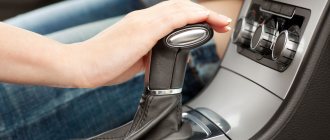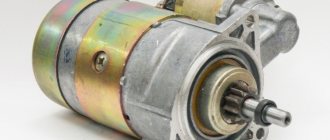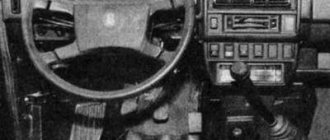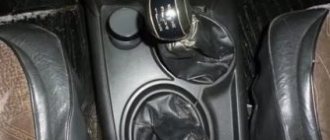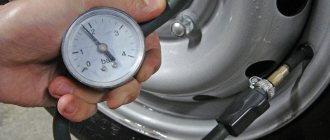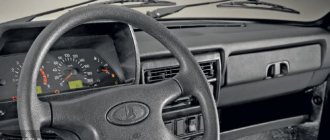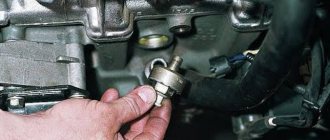— jerk
— short-term spontaneous change in engine speed regardless of the position of the gas pedal.
In everyday use, as a rule, there are a series of jerks; — failure
— a noticeable delay in the engine’s response to pressing the gas pedal. Approximately can be considered as a limiting case of a jerk.
Conventionally, three types of jerks can be distinguished:
- at the moment of starting movement; — during acceleration; — with steady motion, i.e. with the gas pedal in constant position.
When using the DAAZ Solex carburetor, a very unpleasant defect occurs: when you press the gas pedal, a strong dip occurs, the engine stalls, and often there is no idle speed. Movement is only possible when the gas pedal is pressed to the floor, or you have to continuously “pump” the pedal. The reason is clogging of the fuel nozzle of the main metering system of the first chamber.
For an experienced car enthusiast
it is necessary to remove the top cover of the carburetor, as described above, unscrew the two air jets, use a thin screwdriver to unscrew the two fuel jets and remove them from the wells with a long wooden toothpick or a pointed stick.
Do not mix up the jets when reinstalling them!
Then, use a syringe or a clean, lint-free cloth to remove gasoline from the float chamber and blow out the carburetor with compressed air, especially carefully - the fuel nozzle wells.
For an inexperienced car enthusiast
It is better to immediately contact a car service center. To get to the service center, cut off a piece of vinyl chloride tube 1–1.5 cm long (at least from the windshield washer tubes) and place it on the thrust lever of the second chamber drive. The engine speed will be approximately 2000 rpm. Use the clutch and brake pedals to maintain a safe speed.
Jerking when starting to move
At the moment the movement begins, the limiting case of a jerk—failure—occurs more often. The most unpleasant sensations are associated precisely with the delay in the engine’s response to pressing the gas pedal. Sometimes the engine even stalls.
The cause of failure may be either a malfunction of the carburetor accelerator pump or a malfunction of the vacuum corrector of the ignition distributor.
For work you need: wrenches “8” and “10”, Phillips and slotted screwdrivers, a clean rag, a piece of thin copper wire without insulation with a diameter of less than 0.3 mm, a compressor, a can of wd40 type liquid, possibly a portable lamp.
| EXECUTION ORDER |
1.
Remove the air filter housing cover by unscrewing the nut with a “10” wrench and unfastening the spring clips.
Remove the air filter. Unscrew the four nuts with a key “8”, use a screwdriver to loosen the clamp of the crankcase ventilation hose at the connection point to the valve cover and remove the air filter housing.
2.
Disconnect the vacuum corrector drive hose for the ignition distributor and, creating a vacuum with your mouth, check for leaks.
Does air flow freely?
No: see point 4
3.
Contact a car service to replace the vacuum corrector of the ignition distributor.
4.
Look inside the carburetor. The air damper must be fully open. Press down on the throttle lever. Streams of fuel should appear from both accelerator pump nozzle tubes. The streams should be even and directed into the gap between the diffuser wall and the opening damper. If necessary, use a portable lamp.
Is the fuel spray direction correct?
No: see point 6
5.
Contact a car service for diagnostics.
6.
Avoiding fuel spillage, remove the fuel supply hose to the carburetor and the fuel drain hose. Remove the choke control cable and wire from the idle air solenoid valve. Remove the five screws securing the carburetor top cover.
Remove the carburetor cover, carefully turn it over (the fastening screws will fall out - do not lose them!) and place it with the floats up.
Do not damage the floats!
7.
Using a screwdriver, carefully pry it as close as possible to the sealing point of the accelerator pump nozzle tube and, pressing upward, remove the nozzle from the socket.
8.
Clean both holes of the spray nozzle with a thin copper wire.
Blow air into the nozzle in the direction opposite to the direction of fuel flow.
9.
Insert the sprayer into place. Without installing the carburetor cap, press the throttle lever. Streams of fuel should appear from both accelerator pump nozzle tubes.
No: see point 11
10.
Reassemble the carburetor and keep in mind that it is time to carry out maintenance, replace the fine fuel filter or change the gas station.
11.
Check that the accelerator pump drive lever moves easily and that there is no play in the drive. If necessary, lubricate the parts with wd40 type liquid, replace faulty parts. Check the operation of the accelerator pump again.
Causes of car jerking
The first is a “cold start”, the car’s engine did not have time to warm up from the moment it was started until it started driving, which is typical at low temperatures in winter.
The second reason why the car began to twitch is the driver’s inability to properly operate the manual transmission. A manual transmission requires certain skills; if a driver has only used an automatic transmission, then he is unlikely to use a manual transmission and drive with ease. There is not enough knowledge here that when engaging reverse gear you need to turn the lever “here”.
Suspension diagnostics.
From time to time, a knocking sound may appear in the front suspension of the Niva Chevrolet. If this problem occurs, it is necessary to immediately diagnose it. It starts with a visual inspection. It is best to do it on a lift or inspection ditch. The wheels must be hung to be able to check the play of the parts. First of all, rubber parts are checked - anthers and oil seals. They should not have visible mechanical damage, cracks or other signs of aging. It is also necessary to check that rubber-metal products do not have one-sided bulging of the mass or its separation from the reinforcement. In this case, it is necessary to immediately replace the parts.
After this, the protective covers on the balls are checked. They are non-separable, so if there is damage, it is necessary to replace the complete structure.
Particular attention should be paid to the cushions that are located between the hinges and the rubber bushings of the shock absorbers.
After this, the front levers of the Niva Chevrolet are inspected. They are held in place by bushings, which wear out over time.
Replacing the oil seal
rear axle
gearbox on a
Chevrolet Niva
. Checking the breather. Oil seal no.: .
- We disconnect the driveshaft from the gearbox by unscrewing the bolts securing it to the flange.
- We separate the internal CV joint housings from the drive gears.
- Using a dynamometer, we determine the moment of free rotation of the drive gear
. To do this, turn the flange mounting nut until the gear begins to rotate. We fix the magnitude of the moment. - We tighten the bolts into two adjacent flange holes (for fixation).
- We insert a mounting spade between the bolts, hold the flange from turning and unscrew the fastening nut.
- Remove the washer and flange from the spline joint. If it is impossible to remove it by hand, use a universal puller.
7. Remove the oil seal using a flat-head screwdriver. 8. Rinse and thoroughly wipe the replacement area. 9. Replacement of the front axle is carried out only with original Chevrolet spare parts. To facilitate pressing, any grease (litol, grease) is applied to the sealing ring. 10. Press in the ring using a pipe of suitable diameter. 11. Place the flange on the spline connection and put on the washer. 12. Tighten the nut to the torque determined when unscrewing. 13. Fasten the cardan shaft.
- We remove both drives (or the one that requires replacement)
- Remove the retaining ring and spring washer;
- Using a hammer, carefully knock down the bearing. If removal is difficult, treat with a penetrating lubricant, such as WD-40.
- Remove the bearing cap with the old seal.
- Using a pipe, knock the oil seal out of the cover;
- Lubricate the new spare part with any grease and press the o-ring into the cover.
7. We assemble the unit. We fill the gearbox with oil in accordance with the maintenance instructions, do a test drive , and check for oil leaks.
Impact of jerks on the car
Whether jerking the car is beneficial or harmful is a rhetorical question. It’s the same as poking a person with a knife and asking if your health is improving. Any kind of jerking of the car is harmful, be it just a jolt when driving or a consequence of changing gears.
The main impact falls on the transmission unit and the engine part. First of all, the load on moving elements (bearings, switches, gears) increases. Each impact can deform, leave a crack or completely break any of these elements. Repairs can take a long time and cost the car owner a significant amount of money. That is why it is important to initially determine the reason why the car began to twitch and eradicate it.
The car jerks due to engine problems
Let's look into the heart of the car - the engine. What could be the reason why the car jerks when changing gears?
The first reason for engine operation may be uneven fuel distribution, which leads to instability in the movement of the power unit. Jerking of the car can also indicate unstable operation of the cylinders. In this case, the whole reason lies in the spark plugs. A low-quality or worn-out spark plug does not ignite mixtures in the cylinder well, and therefore disrupts its operation.
We should not forget about the human cause of problems with engine operation. Jerks when shifting gears can occur when the quality of the fuel is low. Remember that by saving on fuel and lubricants, you do not save on repairing your car.
If we consider modern injection engines, there may be many more reasons. The operation of such a motor is fully automated to increase the efficiency of the indicators. Yes, injection internal combustion engines are economical, easy to start and operate reliably, but diagnosing a malfunction is much more difficult. The main reasons for car jerking can be either the failure of one of the sensors or the wear of any element. Let's look at some of them:
- a malfunction of the on-board computer indicates a breakdown of the speed sensor;
- worn cables that do not allow fuel to be ignited on a regular basis for stable engine operation;
- clogs in the injector nozzles, interfering with the flow of fuel;
- idle speed sensor failure.
We get rid of vibration and extraneous sounds of the Niva transfer case forever
The characteristic howl and hum of the transfer case on VAZ-21213 cars, alas, is familiar to many owners of such cars. Let’s figure out what is the reason for these problems, and most importantly, how to get rid of them without using “collective farm” methods, such as additional noise reduction.
Content
- Let's understand the terminology.
- We study problems and repair methods. Vibration and how to deal with it.
- We remove the howl and hum.
- We remove the possibility of oil leakage.
- Niva (LADA 4×4)
Understanding the terminology
Let's start by diving into the materiel. Transfer case (TC) is a separate unit of an all-wheel drive vehicle, which provides multi-mode power distribution from the engine to the front and rear axles.
Externally, this is a mechanism located under the bottom of the car, in the body of which a multiplier (divider) is placed in series to obtain an intermediate gear ratio in the transmission and a splitter of one power flow into two. It is with the help of this device and its controls (levers) that go into the vehicle interior that the LADA 4×4 driver selects the all-wheel drive operating mode.
The RK directly connects the front driveshaft and the intermediate shaft (shaft) with the vibration damper to the vehicle’s gearbox. As is probably already clear from the description, this element is connected to the rear axle of the car via a rear propeller shaft.
The car jerks due to faults in the manual transmission
For normal movement of a car with a manual transmission, constant gear shifting is required. The main rule of manual cars is to switch the lever on the box in time and correctly. If you violate the sequence, you can quickly wear out the parts and simply bring the car in for repairs.
In the case of a manual transmission, when changing gears, the car jerks due to the actions of the driver. What should you not do if you are still driving a manual car? First of all, it is necessary to choose the right time to press the clutch pedal and change gears. Do not delay the transition to high gears, and after switching to it, avoid sharp pressure on the gas pedal. The most important thing is that there is no need to press the pedals randomly at speed; every action should be thought through or you will cause damage to your car.
A car with an automatic transmission jerks when driving
Car diagnostics were not invented to suck money out of unknowing car enthusiasts - first of all, it is an opportunity to identify upcoming breakdowns and eliminate their occurrence before the car has to be “hospitalized.”
If a car with an automatic transmission jerks when driving, then the first reason may indeed be hidden in the low air temperature. This occurs due to freezing (thickening) of the oil; preheating will save the car.
Your car may be jerking because it simply doesn't have enough oil. Check its level, it is possible that the reason lies there.
The third reason also lies in the oil. Remember the last time it was changed. Regular replacement will help avoid many problems in car operation.
avtoexperts.ru
From time to time, every car owner is faced with a situation where the vehicle begins to jerk when starting to move when pressing the gas pedal or driving at low speeds. This behavior of the car is often caused by not too serious disturbances in the operation of the internal combustion engine and other systems. However, they need to be diagnosed and eliminated as soon as possible. Otherwise, they can lead to a complex breakdown, which will take a lot of time and money to fix.
When can a car “jerking” appear and what are the causes of the phenomenon?
In the vast majority of cases, the symptom of unstable driving can be diagnosed in the following situations:
• While the vehicle is starting to move (pushing away).
• During slow driving at low engine speeds.
• If necessary, accelerate suddenly while driving on the road.
• While the power unit is operating at high speeds.
In addition, the described behavior of the vehicle may also occur in other operating modes. The reason for this may be malfunctions of the following systems and components of the machine:
1. System for supplying the fuel mixture to the combustion chamber.
2. Ignition system.
3. Incorrect operation of the transmission.
4. Malfunctions in the operation of the car's electronic engine control unit.
How to troubleshoot?
Let's take a closer look at the main and auxiliary systems of the car, which can cause the vehicle to “jerk” while driving. We will also focus on how to eliminate diagnosed problems.
Fuel mixture supply system
Quite often, the cause of unusual behavior of a car while driving is improper operation of the fuel supply system to the engine or the injection system of the air-fuel mixture into the combustion chamber. In other words, the internal combustion engine cannot obtain the required amount of gasoline or diesel fuel. As a result, there is not enough torque from the shaft to transfer mechanical force to the suspension, and you end up with a dip in power.
To get rid of troubles, you need to:
• Check the operation of the throttle assembly.
• Test the functionality of the idle speed sensors.
• Check the correct position of the throttle valves.
• Check the functionality of the mass air flow sensor.
In most cases, the defect is found in the injectors, which are responsible for injecting the fuel mixture. Less commonly, an uneven ride is associated with the air passages that connect the injector and the air filter. Depressurization is possible, which leads to loss of pressure.
The problem found can be corrected by replacing damaged parts. You can do this yourself, but it is better to seek help from service center specialists. After carrying out the work, it is important to additionally check the tightness of connections along all fuel and air supply lines.
Drive gear adjustment
To carry out the operation, use the original device A.95690, mandrel A.70184 or an analogue made according to the drawing.
The crankcase mating plane is positioned so that it assumes a horizontal position. Then an absolutely flat metal rod is installed on the bearing bed. The distance from the bar to the mandrel is measured by inserting the adjusting rings from the set into the gap under the bar in increments of 0.05. The measured value (crankcase base) is consistent with the correction applied to the drive gear. When assembling the unit, it is recommended to abandon the standard spacer sleeve to prevent repeated repairs. Instead, a non-deformable steel bushing 48 mm long is suitable (with a margin, shorten if necessary).
During turning, the parts control the force when turning the gear (should be 157–196 Ncm); for used bearings, a torque of 39.2–58.8 Ncm is valid. The use of a proprietary dynamometer 02.7812.9501 is not necessary.
Acceptable accuracy will be provided by a household steelyard. When working with it, you should wind one end of a 1 m long cord around the flange, and secure the other end to the scales. By pulling the device in a perpendicular direction, fix the turning torque. So, new bearings should provide 7-9 kg, and with mileage - 2-3 kg.
The process involves replacing the support washers with new ones - thicker than before. There are 7 standard sizes to choose from in increments of 0.05 mm within the range of 1.8-2.1 mm. Washer material – bronze or steel. In this case, the gears are installed tightly, but can be turned manually.
Causes of car jerking
The first is a “cold start”, the car’s engine did not have time to warm up from the moment it was started until it started driving, which is typical at low temperatures in winter.
The second reason why the car began to twitch is the driver’s inability to properly operate the manual transmission. A manual transmission requires certain skills; if a driver has only used an automatic transmission, then he is unlikely to use a manual transmission and drive with ease. There is not enough knowledge here that when engaging reverse gear you need to turn the lever “here”.
Again about knocking in the transmission Or play in the transfer case
I apologize in advance for the button accordion topic, knocking has been condemned so many times, however. However, we haven’t gotten to the distribution box yet (or I haven’t found it, having honestly searched several times). So, at 35 thousand, the knocking noise began to appear more and more persistently, especially audible in all-wheel drive. It feels stronger when jerking back and forth in the shit. But it also shows up on rear-wheel drive. I did it simply - they lifted me up on a lift in the car, where I began to “move forward” forward/backward. It was revealed: the main reason for the knocking is a play in the transfer case of 3-5 degrees.
You don’t have to talk about play in the REM. But can anyone tell me about this kind of play in the transfer case?
I don’t know how about 3-5. But there should be some gaps. There are gaps between gears. Also, everyone is selected when changing rotation. More when cold, less when hot. In theory, it was necessary to remove the cardan shafts and check the play in the flanges. Sometimes it breaks in such nodes. Spline connection. Maybe someone can be more precise about 3-5 degrees.
No, well, I’m sort of a mechanical engineer by training, so I imagine gear drives. I was just wondering about the possibility of breaking. There is no whine (ugh three times) - that means the engagement is normal, there is no wear on the gears. I’ll try to go change the oil in the next few days - at the same time I’ll look to see if there is any crap on the plug magnet. Yes, FR new 2008. The mileage is now about 45 thousand.
Yes, there will be shavings there. All our cars are guilty of this. The previous owner put 129,000 on my current car. I did not change the transmission oil. Nothing - she survived. There were shavings on the magnet in the transfer case, but not a lot. But in the box. The cork resembled a spruce forest. Of course you can change the oil. I also have some play and a slight knocking noise when shifting down gears. I think I realized that this is normal for this car. Truck.
Maybe so. Or maybe not. Yesterday, a stranger drove up in the same pepelats, two months younger, but the mileage was 65 thousand. We talked about cars - he doesn’t have that kind of knock. On the other hand, it practically does not move off the asphalt. And last summer I tore out from the river a loaf that we had drowned, for example, which by that time, in addition to its weight, had accumulated 3 tons of water, if not more. I kind of have an idea about the features of all-wheel drive - this is not my first 4x4.
He should have been asked to drive along the concrete wall - perhaps he would have heard. Although who knows, really. In general, judging by the reviews, many have such a knock.
The car jerks due to engine problems
Let's look into the heart of the car - the engine. What could be the reason why the car jerks when changing gears?
The first reason for engine operation may be uneven fuel distribution, which leads to instability in the movement of the power unit. Jerking of the car can also indicate unstable operation of the cylinders. In this case, the whole reason lies in the spark plugs. A low-quality or worn-out spark plug does not ignite mixtures in the cylinder well, and therefore disrupts its operation.
We should not forget about the human cause of problems with engine operation. Jerks when shifting gears can occur when the quality of the fuel is low. Remember that by saving on fuel and lubricants, you do not save on repairing your car.
If we consider modern injection engines, there may be many more reasons. The operation of such a motor is fully automated to increase the efficiency of the indicators. Yes, injection internal combustion engines are economical, easy to start and operate reliably, but diagnosing a malfunction is much more difficult. The main reasons for car jerking can be either the failure of one of the sensors or the wear of any element. Let's look at some of them:
- a malfunction of the on-board computer indicates a breakdown of the speed sensor;
- worn cables that do not allow fuel to be ignited on a regular basis for stable engine operation;
- clogs in the injector nozzles, interfering with the flow of fuel;
- idle speed sensor failure.
The car jerks due to faults in the manual transmission
For normal movement of a car with a manual transmission, constant gear shifting is required. The main rule of manual cars is to switch the lever on the box in time and correctly. If you violate the sequence, you can quickly wear out the parts and simply bring the car in for repairs.
In the case of a manual transmission, when changing gears, the car jerks due to the actions of the driver. What should you not do if you are still driving a manual car? First of all, it is necessary to choose the right time to press the clutch pedal and change gears. Do not delay the transition to high gears, and after switching to it, avoid sharp pressure on the gas pedal. The most important thing is that there is no need to press the pedals randomly at speed; every action should be thought through or you will cause damage to your car.
Replace silent blocks
This name usually refers to rubber-metal bushings, which are used to connect metal parts that are subject to constant vibration or movement. As you know, the transfer case is suspended on two of these.
Over time, they wear out and become stiffer, and the clearances in the bushings increase. If this happens, the vibrations will increase and the rubber bushings will require replacement. It is recommended to install polyurethane, they are much more durable and softer, which also affects the level of vibrations.
A car with an automatic transmission jerks when driving
Car diagnostics were not invented to suck money out of unknowing car enthusiasts - first of all, it is an opportunity to identify upcoming breakdowns and eliminate their occurrence before the car has to be “hospitalized.”
If a car with an automatic transmission jerks when driving, then the first reason may indeed be hidden in the low air temperature. This occurs due to freezing (thickening) of the oil; preheating will save the car.
Your car may be jerking because it simply doesn't have enough oil. Check its level, it is possible that the reason lies there.
The third reason also lies in the oil. Remember the last time it was changed. Regular replacement will help avoid many problems in car operation.

